
| BMW Garage | BMW Meets | Register | Today's Posts | Search |
 |
|
|
 SUPPORT ZPOST BY DOING YOUR TIRERACK SHOPPING FROM THIS BANNER, THANKS! |
|||||||||
Post Reply |
|
|
Thread Tools | Search this Thread |
| 06-24-2013, 04:25 PM | #1 |
|
Lieutenant Colonel
 962
Rep 1,910
Posts |
Ohio: Great Roads and the Best Haunted House Ever
A tour of the best driving roads in Ohio was long overdue. The weather looked perfect for May 30-June 1, so I pointed the ever-willing BMW Z4 westward and set off in pursuit of driving fun and historical exploration. Not to mention a visit with my college roommate Buzz (of "A Nice Morning Drive" and "Red Barchetta" fame) and his wife Linda.
After a mere 341 miles, averaging 69.7 mph and 30.1 mpg, I arrived at the start of my tour: a handsome bridge over tiny Fox Creek near New Concord. This particular bridge wouldn't merit special attention except for the fact that it's S-shaped. Back in the day, apparently, when a bridge needed to cross a stream at an oblique angle, it was easiest to build in an S-shape so that the actual crossing was at right angles to the stream. That way, the arch itself—the weakest link—could be kept as short as possible. This bridge carried all of the horse, cattle, carriage, wagon, and pedestrian traffic along the original National Road, starting in 1828. It also sheltered numerous runaway slaves using the "Underground Railroad" to escape to the north. The bridge, together with the rest of the National Road, was paved with bricks during World War I to facilitate military traffic.  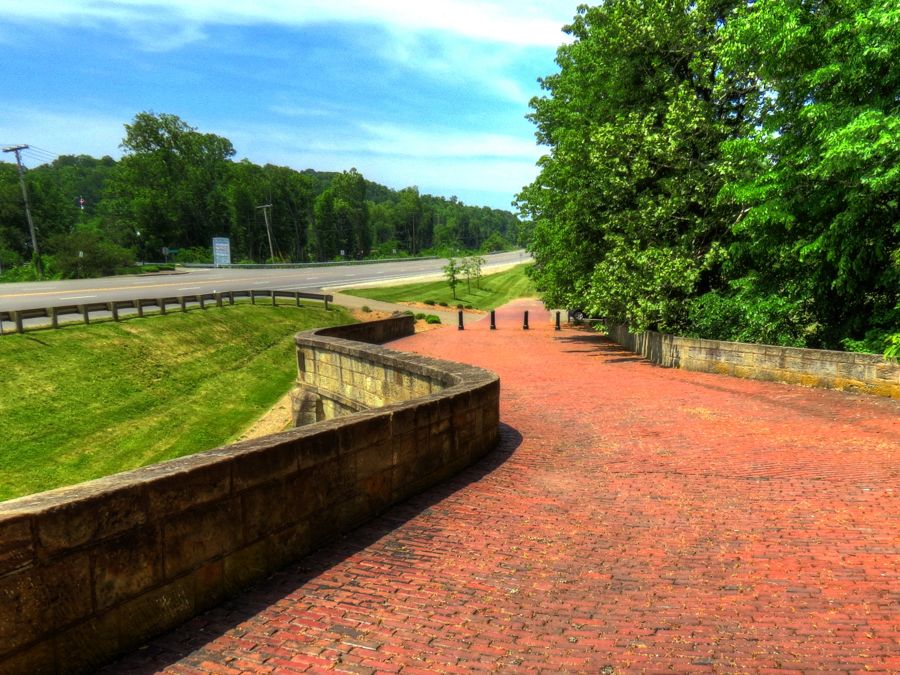 Ohio has a vast number of handsome Victorian houses, including this one in Cumberland…  …and an even greater number of beautiful views of lush countryside. To the far side of the road lies The Wilds, a private, non-profit wildlife conservation area that was built on top of an abandoned strip coal mine. Somewhere in the 9,000 acres are cheetahs, giraffes, and rhinoceroses (oh my!), although I didn't spot any from this vantage point.  Despite the generally lush surroundings, much of Ohio has been experiencing a drought. Here, you would think that I was in the middle of a southwest desert.  The State of Ohio also features almost as many scenic rundown buildings as West Virginia. This was probably a corn crib at one time. Now, however, it is tilting farther and farther from vertical as a result of holding thousands of aluminum cans. 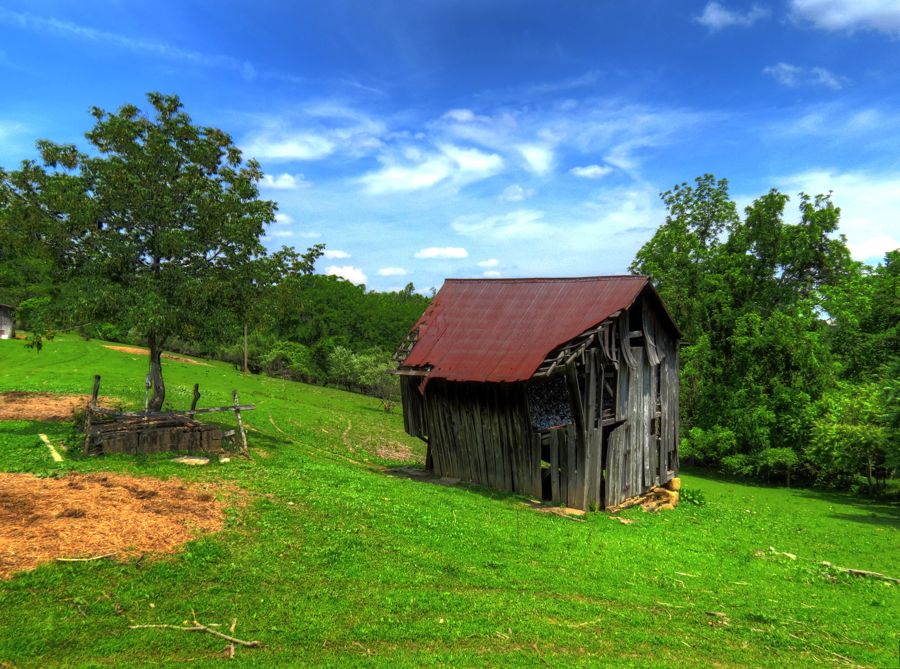  In fact, as I traveled through southeastern Ohio, it seemed that only one in four barns or other rural buildings were in active use. A great many places had become veritable ghost towns.  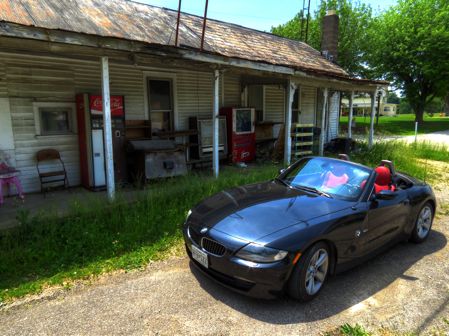   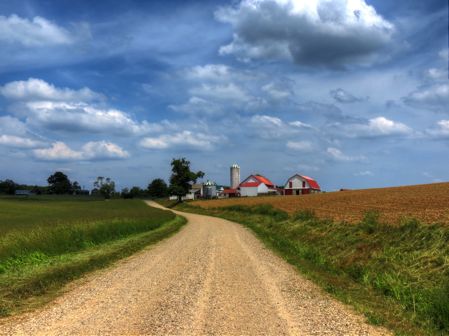 Once again I was following a route from RoadRunner Magazine. The latest issue has a tour called Haunted Ohio: Who Ya Gonna Call?, and it's a corker—some of the best motorcycling and sports car roads you can imagine, including Ohio's version of the Tail of the Dragon. I can recommend it highly for the roads alone; the interesting historic and paranormal locations cited in the article represent icing on the cake. I detoured a bit toward Watertown to find the 1806 Federal-style home of Colonel Simeon Deming. Col. Deming had served with distinction during the American Revolution, and, like many others, was granted land in the Midwest as reimbursement for his military service. My interest in Col. Deming was primarily due to the fact that he was a distant relative of one of my heroes: W. Edwards Deming, the father of modern quality control and management systems in manufacturing throughout the world. Dr. Deming almost singlehandedly led Japan in the 1950s to its now-vaunted status of high-quality automobiles and other manufactured goods, with the U.S. adopting Deming's principles in the 1980s to remain competitive. The cars we drive and the motorcycles we ride—not to mention the TVs we watch, the iPADs we use, and virtually every other product we own—are immeasurably better than they would have been in the absence of this genius' efforts. Toward the end of his long life, Dr. Deming received the National Medal of Technology from President Reagan in 1987, the Distinguished Career in Science Award from the National Academy of Sciences in 1988, and induction into the Automotive Hall of Fame in 1991.   Col. Deming's property also seemed like a good spot for a scenic photo of my long-suffering but much-loved Z4.  Nearby, the Harra Covered Bridge has afforded shelter to those crossing the South Branch of Wolf Creek from 1875 through the late 1990s. I was to encounter many covered bridges on this trip through Ohio, some on purpose and others by complete serendipity.  The bridge also offered a good view of this recently expanded goose family.  Not surprisingly, Churchtown featured the glorious Saint John the Baptist Catholic Church, which dates back to 1866. They don't build 'em like they used to.  The same could be said of the W.P. Snyder, Jr., a sternwheel steamboat that was used to push coal barges up and down the Monongahela River from 1918 through 1953. The vessel has been moored at Marietta on the Muskingum River for many years and is now part of the Ohio River Museum. It is the only such towboat that still exists on American waterways. (Historic photo courtesy of the National Register of Historic Places.)  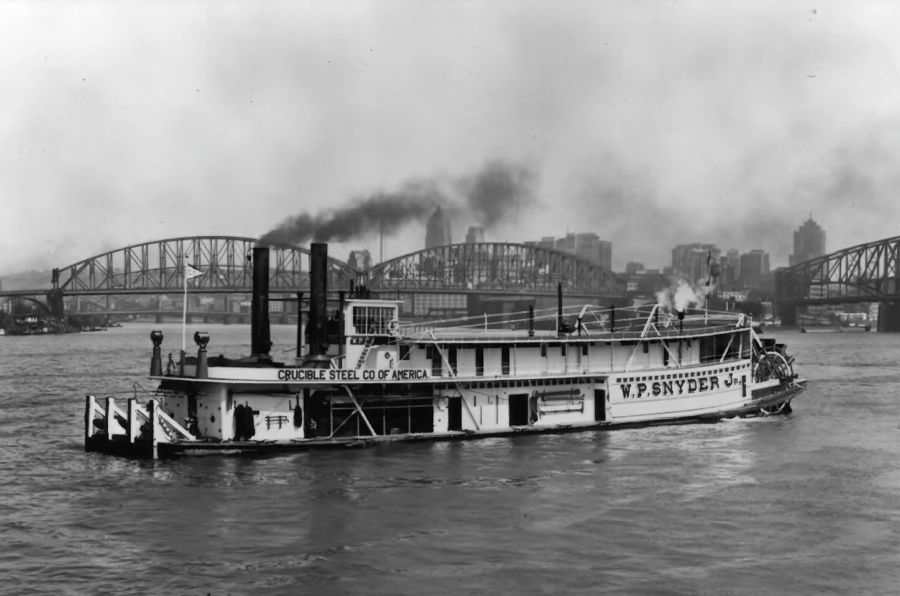 The Ohio Land Company Office was constructed in 1788 and is believed to be the oldest building in all of Ohio. Marietta, OH was the first permanent settlement in the Northwest Territories, and Rufus Putnam led the first colonizing party here after learning of the area's beauty from his friend George Washington. (Washington had visited this area as a young surveyor.) For regular readers of these reports, Rufus Putnam was the half uncle—as best I can tell—of Israel "Old Put" Putnam of Revolutionary War fame. (Old Put famously rode his horse straight down a steep flight of stone steps to escape the British during the war.) The historical drawing of Rufus Putnam landing at the junction of the Muskingum and Ohio Rivers is courtesy of the Ohio Historical Society.   While in Marietta, I wanted to get a look at "The Castle," which was built in 1855 and is now a museum. The good news was that the museum was open. The bad news was that it was closing in 5 minutes. Thankfully, the staff took pity on a hapless tourist and volunteered the time to show me the video and give me a quick tour of the inside of the elegant Gothic Revival mansion. I was taken by the story of Jessie Davis, who lived there in the late 1800s as a precocious little girl and eventually inherited the mansion at age 55. She moved back in and lived there until 5 days shy of her 100th birthday. It's a beautiful place, and now I want to live there. I wonder how much a year-round museum pass would cost?  It may be that the Ohio Land Company Office is the oldest building in Ohio, but there are far older "buildings" of another sort throughout the state. In 1801, the Mound Cemetery in Marietta was built around this ancient Native American mound. Such mounds were generally used for ceremonial purposes, including funerals. This one was built by one of the tribes of the Ohio Hopewell Culture, sometime between 100 and 500 AD. As for the later colonial cemetery, its claim to fame is that there are more officers from the Revolutionary War buried here than anywhere else in the country.  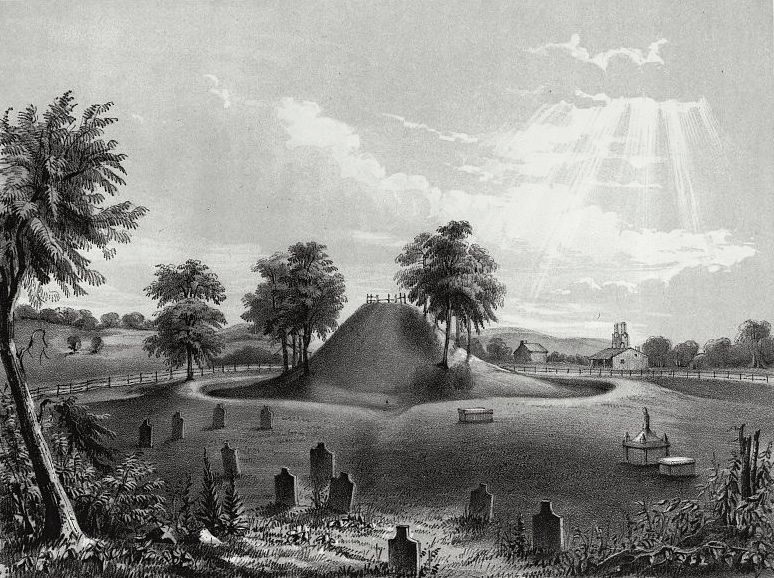 As noted in the RoadRunner Magazine article, the Lafayette Hotel is well known for various hauntings, with the third floor being particularly notorious. Check out The Lafayette Hotel from Forgotten Ohio for a full roster of the hotel's ghosts. (Maybe they should be called "ghuests"?)  Fort Harmar stood on the other side of the Muskingum River, a little downstream from this abandoned railroad bridge and right at the river's junction with the Ohio River. It dates back to 1785 and was built to defend the planned settlement at Marietta from Indian attacks.    Today, the Harmar Historic District in Marietta is a popular tourist attraction. As for the railroad bridge, it's one of the very few unused drawbridges that still works—in this instance, by swiveling an entire section of the bridge to allow ships to pass through. It's opened once a year during the town's "Pioneer Days" festival.   It took me three tries to find The Anchorage, my last stop in Marietta. It's located at the end of a narrow, one-lane drive on the side of a steep hill facing the Ohio River. Douglas Putnam ("Old Put's" great grandson) built the place in 1859, in the Italianate style. It may have been part of the Underground Railroad in Ohio; Douglas' brother David was a prominent abolitionist in Marietta, and there are large tunnels leading from the basement of the mansion. (An interesting account of this possibility is given by local resident Lynne Sturtevant.) Naturally this 22-room home is said to be haunted—in this instance, by the ghost of Eliza Putnam, Douglas' wife, who lived here for only 3 years before dying. (Old photo courtesy of the Washington County Historical Society of Ohio.)  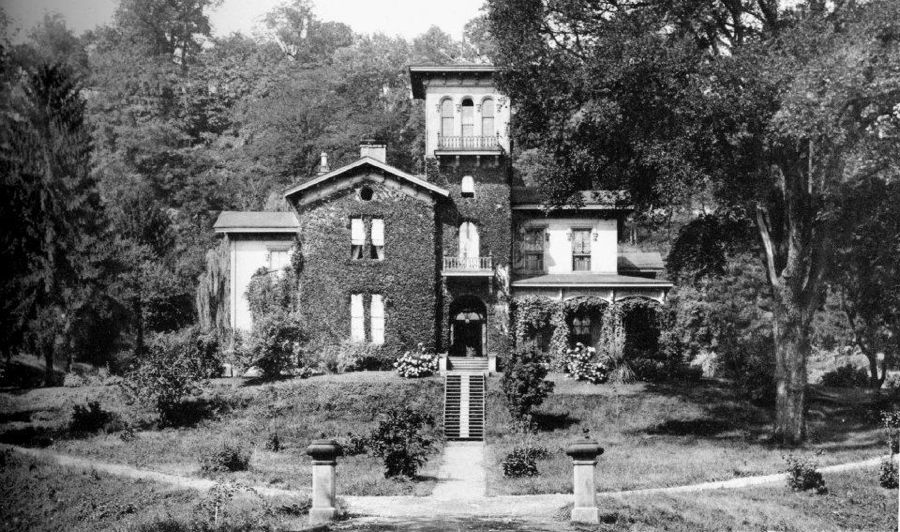 It seems that you can't swing a dead cat in Ohio without hitting at least one ghost. Marietta was a fascinating place, but I was well behind schedule for this first leg of my tour. I made good time on Route 550, which proved to be an outstandingly fun road. But then I found Route 555, which was laid out in 1938 and is often called "Ohio's Tail of the Dragon," after the famous byway in Tennessee. I picked it up toward the end of its 62 miles and thoroughly enjoyed the twisting, turning, roller-coaster ride down to Little Hocking on the Ohio River. It's hard to imagine a better vehicle than the Z4 for tackling the "Triple Nickle" (although a BMW S1000RR might do the trick…) Of course, I need to go back and do the rest of 555 at the first opportunity. It's also worth mentioning that, as I motored briskly along 555, around one blind corner I suddenly encounter a "gleaming alloy air car … two lanes wide." (You Rush fans will get the reference.) It proved to be a huge farm harvester, lumbering along the road and taking up its entire width! It was a good reminder of why we always maintain a safety margin on public roads. I was able to slow immediately, and, by both of us scrunching over to our respective sides of the highway, we passed by without incident. Further along 555, I found the Root Covered Bridge (but few signs of the town of Root itself; it has now largely disappeared).  Little Hocking has been home to many generations of the Curtis family, dating back to at least the late 1600s. Nathaniel Sawyer built this house in 1798, and Horace Curtis expanded it in 1828 and immediately used it to initiate the operation of the Underground Railroad in Ohio. Today, the house looks surprisingly modern until you notice the massive, English-style, central chimney.  Horace Curtis' brother Walter was a prominent local politician and lived a little further downstream on the banks of the Ohio River. He built one of the finest farmhouses in this part of Ohio in the early 1800s, in the Greek Revival style. Abandoned for many years, the house is now all but invisible from the road. (Winter photo courtesy of the National Register of Historic Places.) 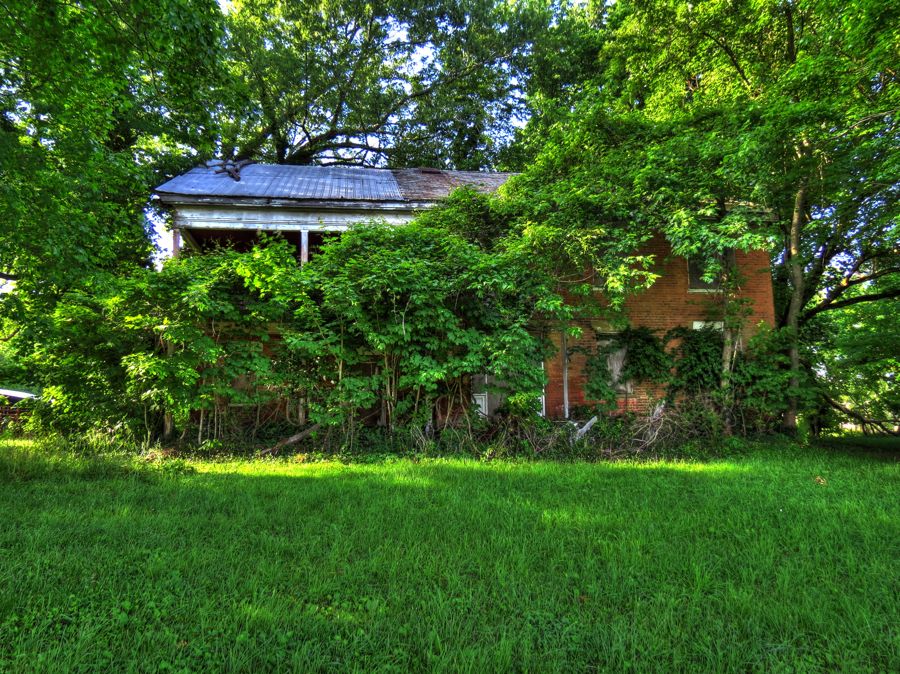  I decided to depart a ways from my planned route to visit a place I hadn't been to for a number of years. As I neared the Fur Peace Ranch, I noticed an abundance of wild black rabbits. Odd, but definitely photogenic (and willing to pose for a 3-exposure HDR photograph).  The guitar ranch, by the way, is owned and operated by Jorma and Vanessa Kaukonen. Now, "If you don't know Jorma, you don't know Jack!" So I'll remind you that Jorma was the lead guitarist for the Jefferson Airplane, and Jack Cassidy was the bass player. They're still active all these years later as Hot Tuna. The Fur Peace Ranch offers instruction in electric and acoustic guitar as well as in other instruments and song writing. It's a wonderful experience, but on this particular Thursday, the gate was locked and no one was home. Pomeroy was my next port of call. It's perched right on the Ohio River and, consequently, has been flooded many times over the years. The Ohio River's first coal barges were loaded here in the 1800s, and barge traffic continues to operate today. 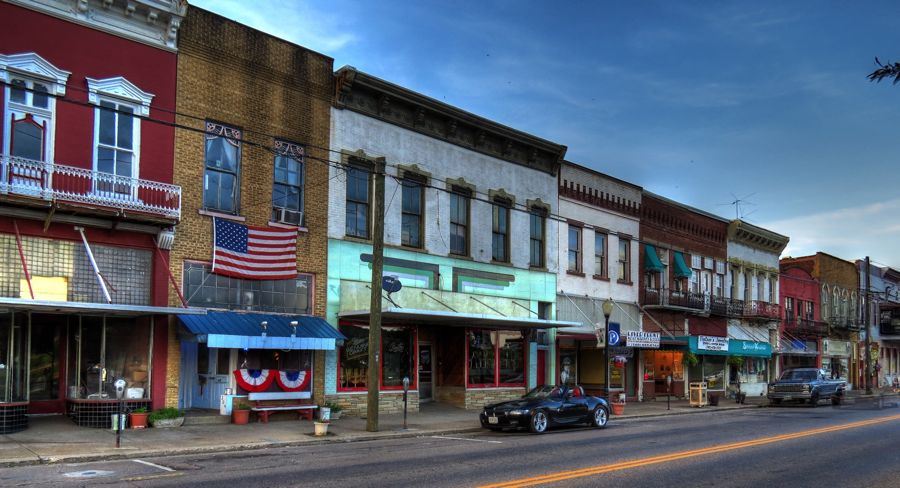  My destination for the night was Gallipolis, Ohio, and I got there with just barely enough light left to find the several places of interest I'd mapped out. I drove down to the water's edge on a virtually nonexistent path in search of the first of these, namely this railroad bridge across the Ohio River into Point Pleasant, West Virginia. It was scenic enough, with its reflection in the water's surface—but it's also a reminder of the Silver Bridge that used to stand nearby.   The Silver Bridge carried vehicular traffic between the two cities from 1928 to 1967. Tragically, on December 15, 1967 at the height of rush hour, the bridge collapsed without warning, sending cars plummeting into the river below and killing 46 of the drivers and passengers. The bridge used an eyebar-chain suspension design. When built using rows of four to six redundant eyebar links, together with a high "excess strength" factor (e.g., ten), such bridges are very safe. But the Silver Bridge was built without redundancy and with a much lower excess strength factor. The bridge's structural integrity was further jeopardized by the greater number and weight of passenger cars and trucks over time. The stress failure of a single eyebar link brought the entire bridge down in less than a minute. A noted engineering historian wrote that it was "a design that inadvertently made inspection all but impossible and failure all but inevitable. If ever a design was to blame for a failure, this was it."   The collapse of the Silver Bridge led to a nationwide program of bridge inspections—but not to the prevention of all bridge failures, as we have seen in recent times. I also found the confluence of the Kanawha and Ohio Rivers, where the Battle of Point Pleasant occurred in 1774 when 1,000 Virginia riflemen were attacked by roughly 300 to 500 Shawnee Indians. The Native Americans were trying to prevent the colonial militia from moving into Ohio. Although a formal settlement with the Iroquois had granted such access 6 years earlier, the Shawnees had not been part of the negotiation and refused to accept it. A fierce battle ensued, eventually resulting in the withdrawal of the Indian forces and a subsequent treaty allowing access to Ohio and granting all Shawnee lands south of the Ohio River to Virginia.   By now, the sun had disappeared below the far shore of the Ohio River. With a quick look at the reconstructed 1776 Fort Randolph, it was time to go looking for the infamous Mothman…   Exactly 13 months before the collapse of the Silver Bridge, a number of Point Pleasant residents reported seeing a large, flying man with a wing span of about 10 feet and bright, glowing red eyes. Two married couples said that the creature had flown behind their car for more than a mile, and a group of gravediggers saw it flying through the nearby woods for about a minute and a half. One man heard a disturbance in his corn field and saw a large pair of red eyes reflecting in his light. He sent his highly agitated German Shepherd into the field—and the dog never came back out. Over the next year, more than 100 people said they had seen the flying person, who soon became known as the Mothman. Following the bridge collapse, the Mothman was never seen again. In 1975, John Keel wrote a book called The Mothman Prophesies, portraying a connection between the Mothman and the bridge disaster. Richard Gere and Laura Linney starred in a 2002 movie of the same name.   Explanations ranged from the prosaic (a Sandhill Crane far from its normal migratory path) to the imaginative (an alien being from a UFO, investigating the World War II munitions site located just outside of Point Pleasant). Your guess is as good as mine. The only Mothman I managed to spot in the town was this statue, created in 2003 in conjunction with Point Pleasant's first Mothman Festival.  But I still want to know what happened to the German Shepherd… By now it was after 9:00 PM. I called and booked the last room at the Gallipolis Hampton Inn and looked around in vain for an open restaurant. Fortunately, the local Bob Evans came to the rescue. A western omelet and some strawberry shortcake revived my spirits, which had been worn down by bridge disasters, unfair treatment of Native Americans, and the odd Mothman or two, and then I was off to a good night's sleep. I'd covered 340 miles of highway driving to get to Ohio, plus 210 more miles of touring on this first day. Last edited by Rick F.; 09-23-2015 at 03:55 PM.. |
| 06-24-2013, 04:26 PM | #2 |
|
Lieutenant Colonel
 962
Rep 1,910
Posts |
The next morning gave promise to another beautiful day. I was up early and managed to find my first destination without difficulty—namely the Wood Old Homestead, where Bob Evans (yes, that Bob Evans), his wife Jewell, and their six children lived for 20 years. Back in the 1820s, the Evans' brick home had been an inn on a stagecoach route.
 As I continued on, I spotted any number of interesting old buildings and even a couple of Baptist churches in Fishkill for Cathy and Kim. I was invited to tour the inside of the First Baptist Church by its pastor, Andy, but I had another 300 miles of touring to do before reaching Wooster in time for dinner with Buzz and Linda, so I reluctantly pressed on. 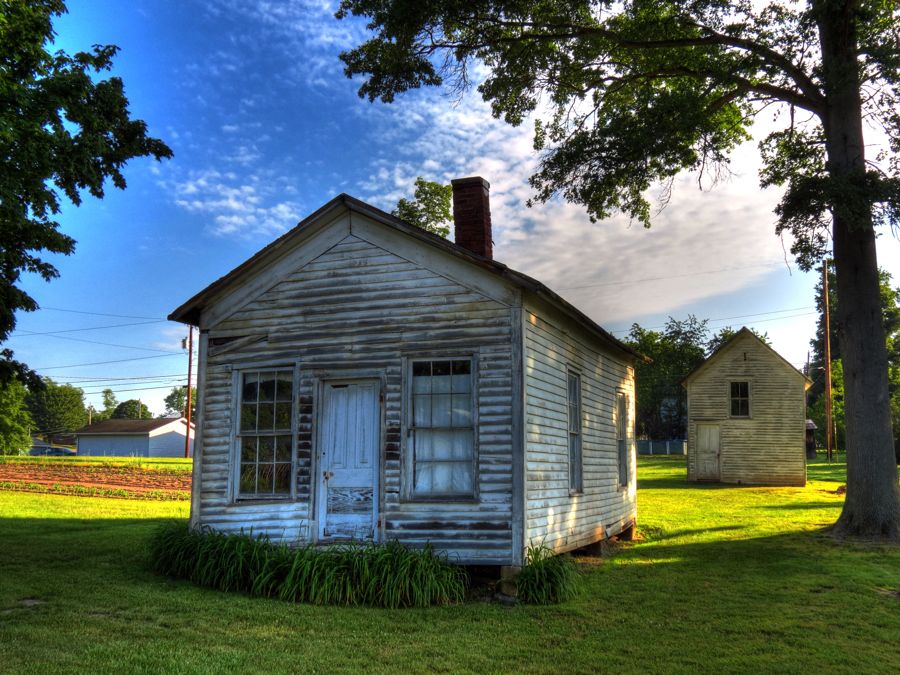 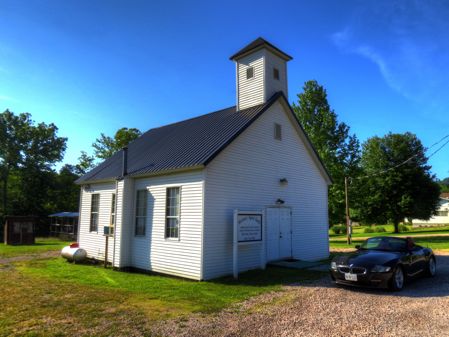 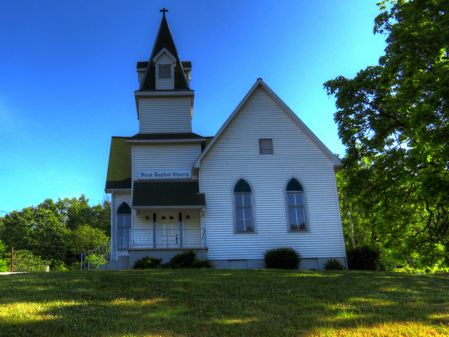 I found this covered bridge over Pigeon Creek in the semi-nonexistent town of Byer on only the second try. (And why do some people insist upon parking their cars in the middle of a one-lane bridge, anyway?) 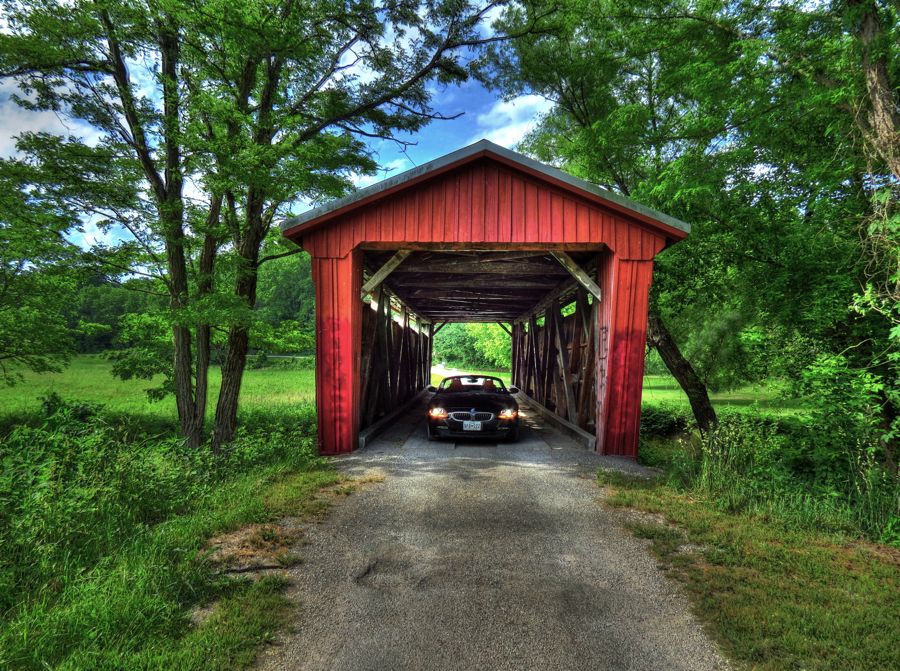 Eventually I reached Chillicothe and found its oldest surviving building—the former home of Mary Tiffin Worthington and her hapless husband David McComb. Her father was Thomas Worthington, who was governor for the Territory of Ohio and was instrumental in achieving its Statehood. He soon became one of the first two Senators from Ohio and later served as the State's governor. In the meantime, poor Mary discovered that her new husband was ineffective at farming, business, and pretty much everything else he tried. The couple lived in this 1813 home for several years before trying to make a better life in Florida. When that failed, they were moving to Texas when Mary became ill and died at age 39, with her husband committing suicide a year later. Their graves are in Texas but have never been found.   The Ross County Courthouse in Chillicothe hasn't changed much over the years—but the surrounding traffic certainly has.  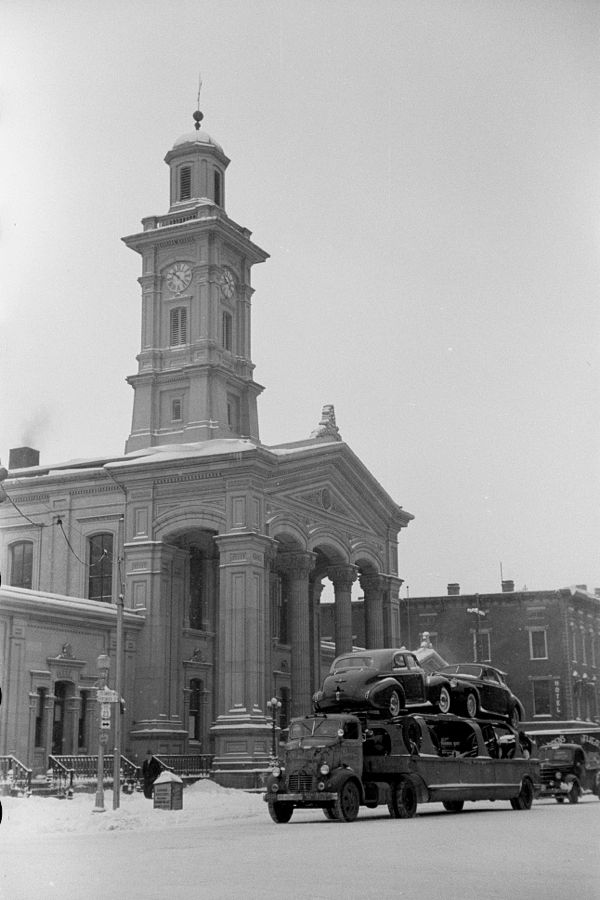 Mound City is situated 4 miles north of Chillicothe, and it is one of 14 areas comprising the Hopewell Culture National Historic Park in Ohio. The Native American Hopewell Culture dates back to 200 BC and is famous for its ceremonial and burial mounds, geometric earthen designs, and beautifully crafted figures, copper decorations, and other items. The 23 mounds at this location were primarily used for funeral and cremation ceremonies. For good measure, the Hopewell people constructed an earthworks wall around the entire site.   Sadly, much of this area was either destroyed or badly damaged by the Army's construction of Camp Sherman during World War I. The Ohio Historical Society restored the mounds where possible following the demolition of the camp.  The National Park Service's museum at Mound City is small but fascinating. It has an excellent display of artifacts found in the area, and the NPS Rangers are very knowledgeable and quite helpful.  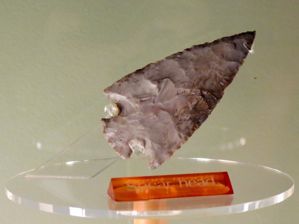  The nearby Wesley Chapel was the center of community activities for tiny Hopetown, OH, starting in 1834 with the portion on the left in this photo. The five-sided addition was built in 1888, and—prior to a devastating lightning strike in 1926—the rectangular section surrounding the main entrance supported a large tower. The church is no longer used, but its Gothic Revival architecture is still in good condition.  Hocking Hills State Park merits a several-day visit, but I only had time for an hour. I used it to take the short hike to Ash Cave, which is a spectacular overhanging rock formation, complete with a small waterfall. This and other "caves" were popular tourist attractions as far back as 1870, although that history pales compared to that of the Native American Adena Culture that lived here as long as 7,000 years ago.   The scale of these "black hand sandstone" formations is hard to appreciate in photos. If you look carefully in the earlier two, various sightseers are visible beneath the cliffs. I'm told that some of the other areas of the park are even more stunning.  By comparison, farms that were abandoned in the 1970s or 1980s seem as recent as yesterday.  Although this trip report is designed to focus more on ghost towns than ghost stories, there's one that must be told. Long ago, there was a house made of mud near Lancaster, Ohio. The dirt path that led to the home was improved over time and named "Mudhouse Road." Nicer homes were built, along with large farms, and eventually the original mud house ceased to exist. The grandest of the farmhouses in the area became known as "Mudhouse Mansion." The once-elegant "second empire" house was built in the early to mid-1800s and is visible in the distance in this photo. You can't get any closer without Serious Trespassing, and this property is owned by a woman who dearly loves to prosecute miscreants.  One can, however, zoom in on Mudhouse Mansion from the safety of a public road. Even without any associated ghost stories, this view should be enough to make your skin crawl a bit.  But of course there are associated stories—at least three different ones. But this one is my favorite: In 1892, a husband, wife, and three children moved into the house. Neighbors saw them move in but did not ever observe them leaving the house or working the fields. After several weeks, one woman saw the mother standing in front of an upstairs window, wearing a white dress. The following day, the mother again appeared in the same window and again wearing a white dress. This pattern continued for a full 10 days before the witness asked the police to investigate. The police had to break into the house, since no one answered the door. There, they found the woman in front of the window—but she wasn't standing… The entire family was hanging from ropes, each individual in a different room, and all of them wearing white bedclothes. Whether it was a mass suicide or a mass murder was never determined. Afterwards, the house was never lived in again. The house has inspired a lot of commentary, secret visits to the interior (see Forgotten Ohio as an example), and even various forms of artwork. In the latter category, ElectricFunderal's "A Glimpse of the Afterlife" is in a class by itself: 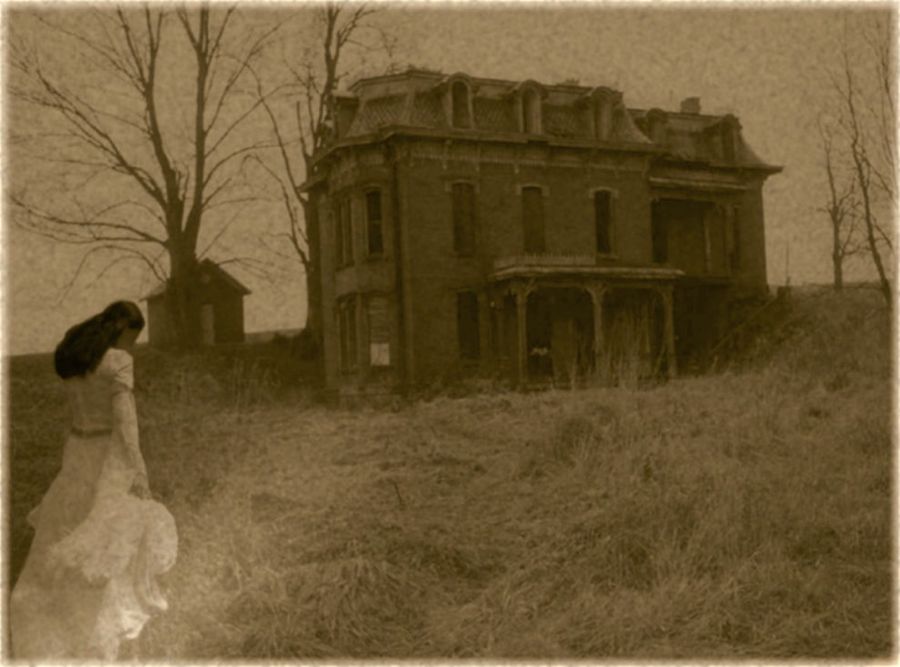 As best I can tell, there is no truth to any of the chilling tales about Mudhouse Mansion, including the one above. Regardless, I still nominate this as the Best Haunted House Ever. The beautiful views around idyllic Buckeye Lake were a welcome change from the mansion and its stories. But its monumental amusement park, which thrived from 1892 to the Great Depression, and lingered through the mid-1960s, is long gone.  Since I still had a quite a ways to go before reaching Wooster and my 7:00 PM dinner rendezvous with Buzz and Linda, I had to forgo a trip through Rushville. (Sorry Neil. Next time for sure.) This photo shows the Native American "Alligator Effigy Mound" from the side. It doesn't look like much, since the mound was designed to be seen from above, from which vantage point it is shaped somewhat like an alligator. Later archaeologists believe that it actually represents the mythical "underwater panther," a powerful cat-like being with scales and spikes. No one knows why Indians would go to so much trouble to create something that could only be observed from high in the sky—but speculation abounds. The Fort Ancient Culture is believed to have built the mound sometime between 700 and 1200 AD. Today, the Alligator Effigy Mound is surrounded on all sides by a very upscale housing development, full of "MacMansions." (The photo of an Ontario pictogram of an underwater panther is courtesy of D. Gordon E. Robertson, Ph.D. and Wikimedia Commons.) 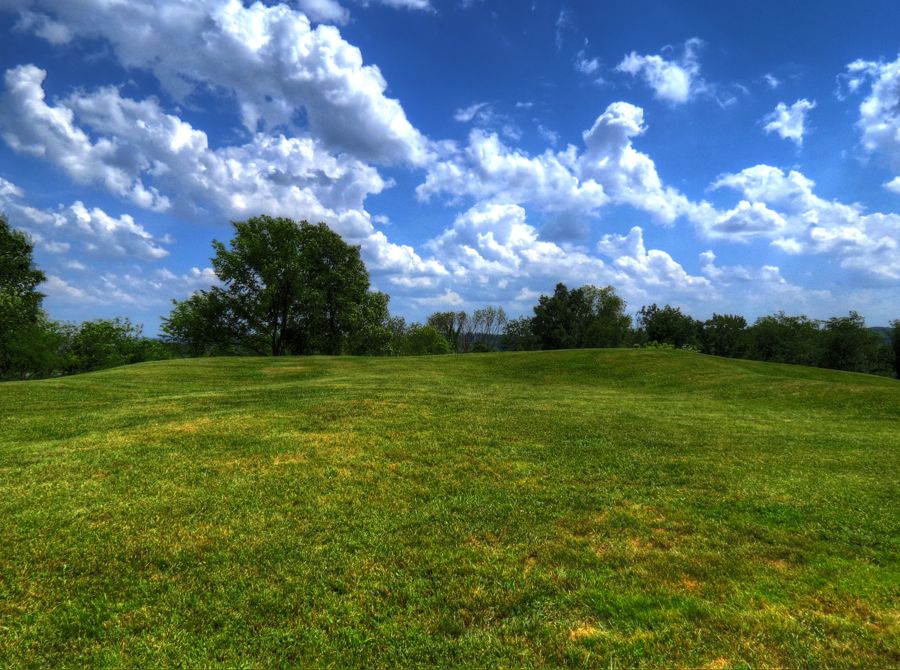  The Longaberger Company is headquartered near Newark, Ohio and has been making handcrafted baskets since 1919. This 7-story building is its headquarters!  The beautiful weather was holding up well so far, but I began to notice a gradual buildup of clouds. All the better for scenic HDR photos. This one was taken on the appropriately named "Crooked Road," which featured a dozen or so sharp right-angle corners connected by perfectly straight sections. 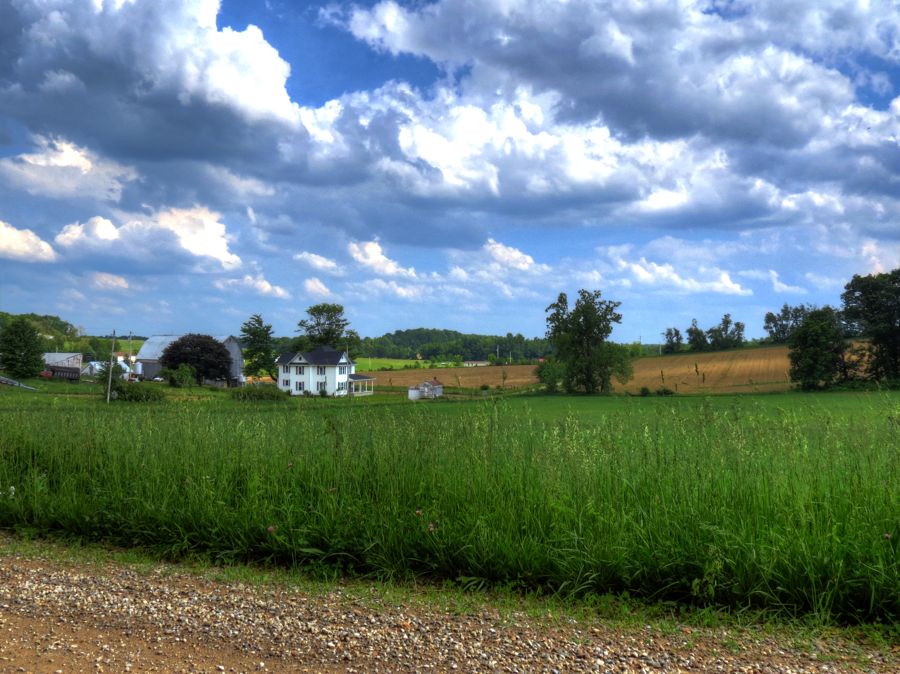 As best I could tell, these buildings used to be a granary alongside the Baltimore & Ohio railroad tracks in Butler.  The "Big House" at Malabar Farms was built by author, conservationist, and Pulitzer Prize winner Louis Bromfield in 1939. It appears as though sections were added onto the house over the years, but it was actually built this way to give such an appearance. In 1945, Humphrey Bogart and Lauren Bacall were married at the Malabar Big House and honeymooned here as the guest of Louis Bromfield. Today, the Malabar Farms estate is a state park. On the day of my visit, the Big House was undergoing significant renovation, and the various sections displayed different shades of primer, rather than their traditional white paint. 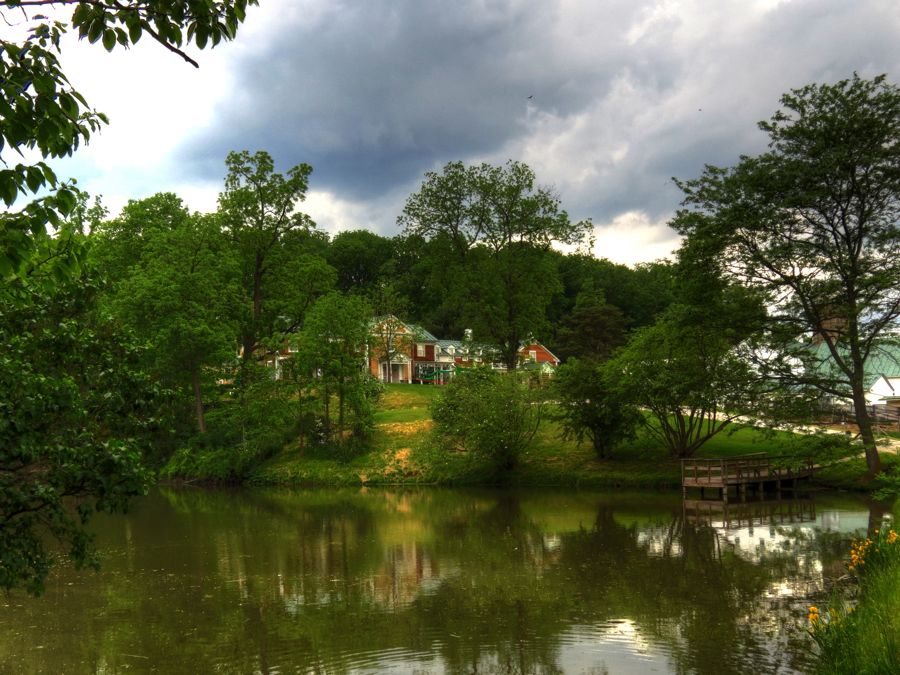  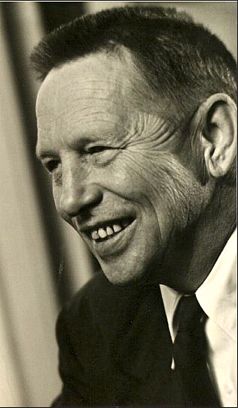    As I drove the faithful Z4 into Mansfield, I realized that those fluffy photogenic clouds were taking over the sky in earnest. They provided a dramatic backdrop for this colorful house… 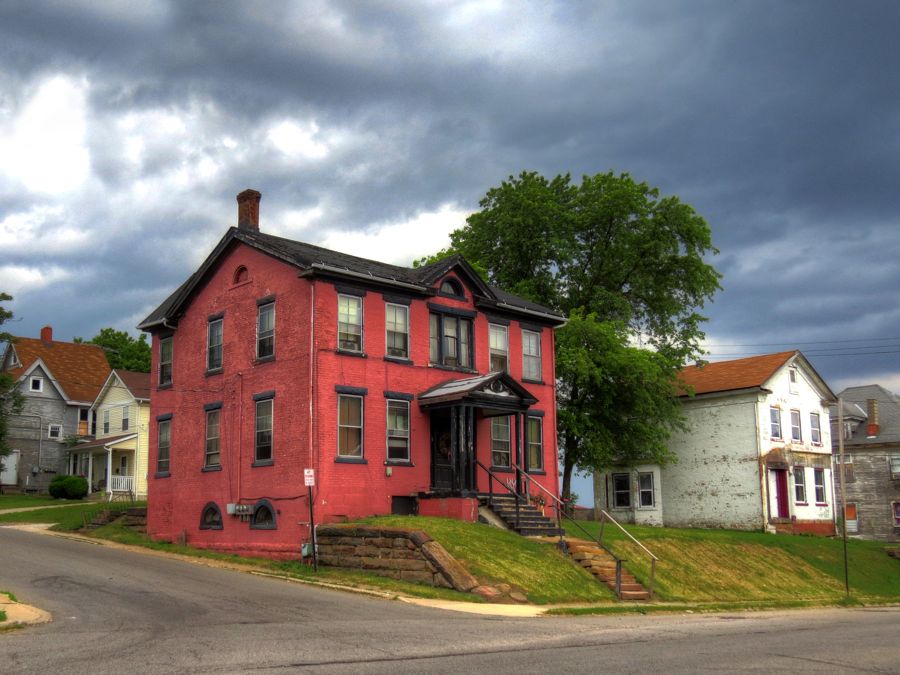 …and for the magnificent Park Avenue Baptist Church. And as I was walking back to the roadster, the skies opened up in a way that brought visions of Noah and the Flood. I decided to forgo the historic 1896 Mansfield Reformatory (which was used in filming the Shawshank Redemption) and to head directly for Wooster instead.   After negotiating 30 miles of driving rainstorm, I found my best friends Linda and Buzz and their granddaughter Savannah all waiting for me. We had a great reunion, somehow fitting dinner and ice cream into the mix, and Buzz gave me some very helpful route tips for the following day based on his extensive Ohio motorcycling experience. I was glad to tumble into bed that night, after 310 miles of heavy-duty touring.  Last edited by Rick F.; 09-23-2015 at 03:58 PM.. |
|
Appreciate
0
|
| 06-24-2013, 04:27 PM | #3 |
|
Lieutenant Colonel
 962
Rep 1,910
Posts |
I was up early the next morning and feasted on a breakfast of Buzz's scrambled eggs and Linda's blueberry muffins. As I motored off to resume my tour, I naturally had to stop at my Alma Mater, the College of Wooster, for a look around. This is Kauke Hall, where I studied Economics, Sociology, Art, and a few other topics that have been lost to time.
 Wooster dates back to 1808 and has its own fair share of beautiful houses to rival those of other, more prominent places. This is the Liggett-Freedlander house, from 1880. Herman Freedlander built the department store in Wooster that carried his name and operated from 1884 to 1989. And if the house isn't sufficiently beautiful, take a look at the adjoining garden.   I detoured several miles from the RoadRunner Magazine route to visit Perrysville, OH. It featured a muddy stream and a worthy Baptist church…   …and also the Perrysville Drive In, which offered a cluttered and eclectic menu and was even open early on this Saturday morning.  Behind the Drive In, I met this enticing young woman. She was charming and beautiful but didn't say much. 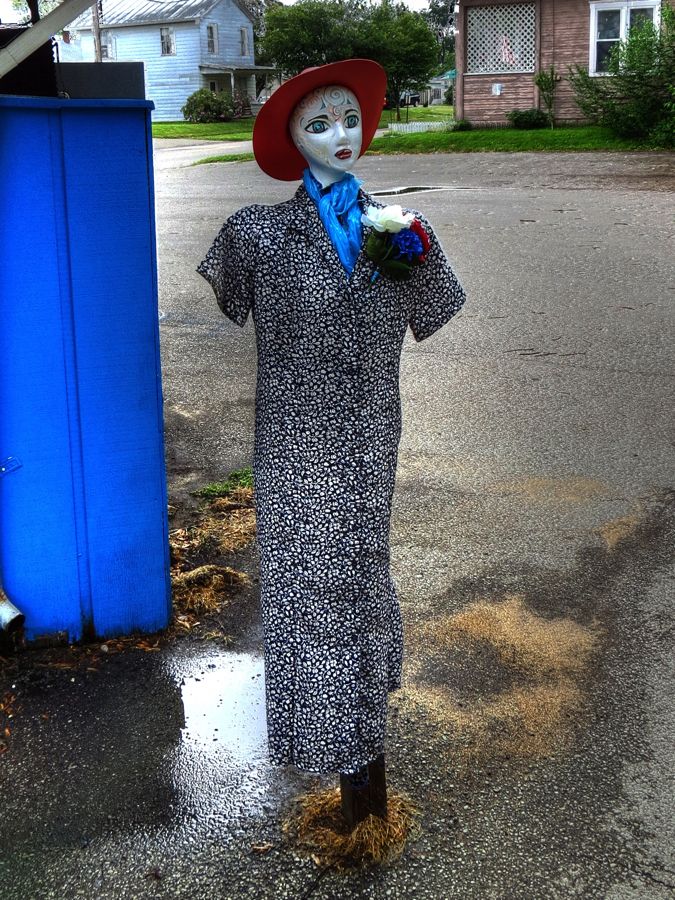 Perrysville is very much like a multitude of other small Ohio towns—with the notable exception of the following story: During the War of 1812, the British recruited many Indian tribes to help fight the American colonials. A detachment of the colonial army came through Perrysville and asked the town's minister, James Copus, to persuade the large Greentown Native American village to relocate temporarily, to put them out of reach of British influence. Rev. Copus reluctantly talked with the Indians, who were reluctant to move but trusted him enough to do so. Once Copus and the Indians were a few miles out of town, however, the Army ransacked their village and burned it to the ground. The Greentown Indians were furious, naturally, and exacted revenge on several local families—including Rev. Copus, who was killed defending his family. His teenage daughter Sarah escaped through an opening in the roof and ran for help. In most versions of the story, she encountered the legendary Johnny Appleseed, who helped her reach safety and find a rescue party. At the dedication of the Copus Massacre Memorial, shown below, Sarah Copus Lambright was a spry 83-year-old and was grief-stricken by the memories of that day. A good (if somewhat "settler-centric") account of these events is available at The Copus Massacre. 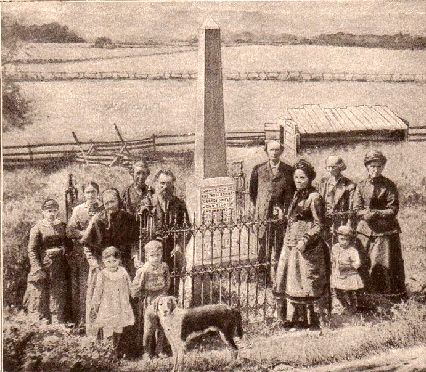 As for Johnny Appleseed (John Chapman), he visited the Perrysville area many times over years, became friends there with Roselia Rice (who went on to become a well-known writer and documented his adventures), fell in love with Perrysville's Nancy Tannehill, but was jilted and never considered marriage again. He lived past age 70 and is credited with establishing apple orchards and nurseries all over Pennsylvania, Indiana, and northern Ohio. I returned to Loudonville, OH, scene of dwellings grand and small, plus a handsome Baptist church. 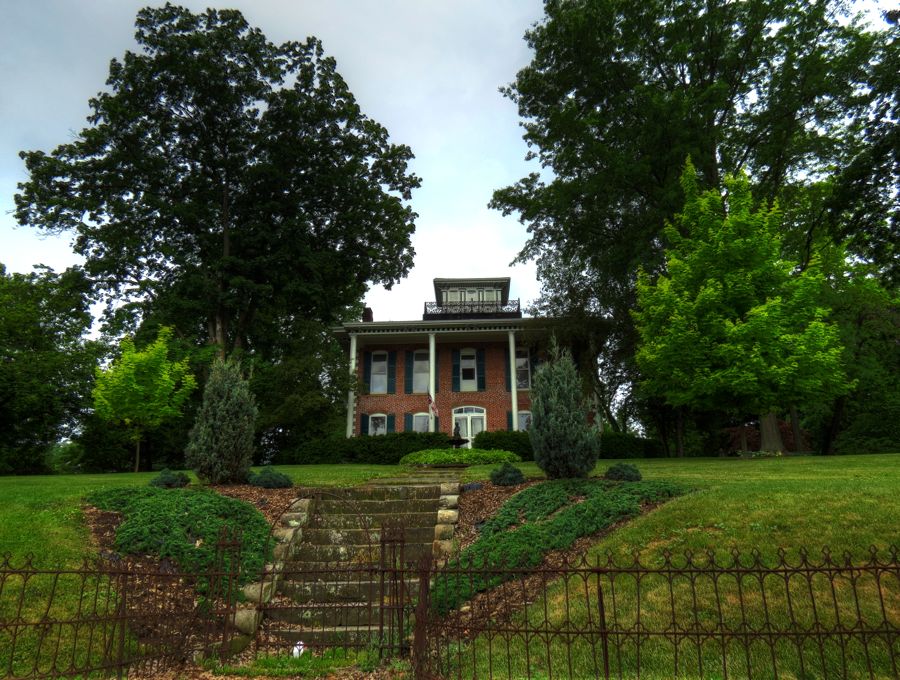 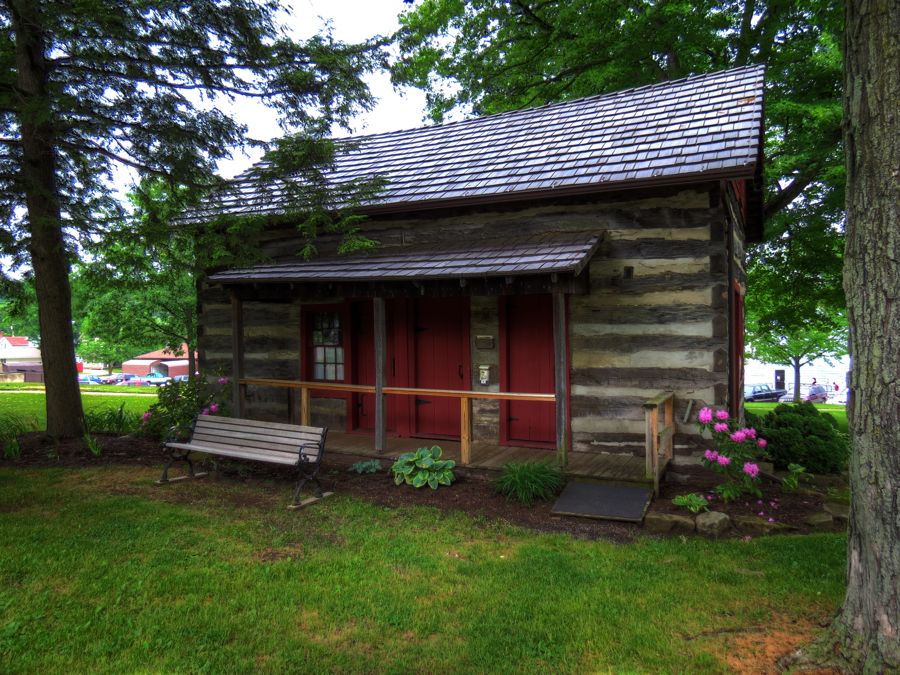  At Buzz's suggestion, I took Route 541 from Loudonville to Coshocton, and it proved to be exactly as he described it: An ideal road for motorcycling and sports cars. Similar to Highway 555, it was quite an enjoyable roller coaster. Along the way, I found an all-too-typical sight with Harley Davidsons lined up in front of a local bar (at 10:30 in the morning, no less)…  …a weathered old barn that is still standing strong…  …and yet another Ohio ghost town, with sad testimony to the last family's rapid departure, leaving a child's toy truck behind.   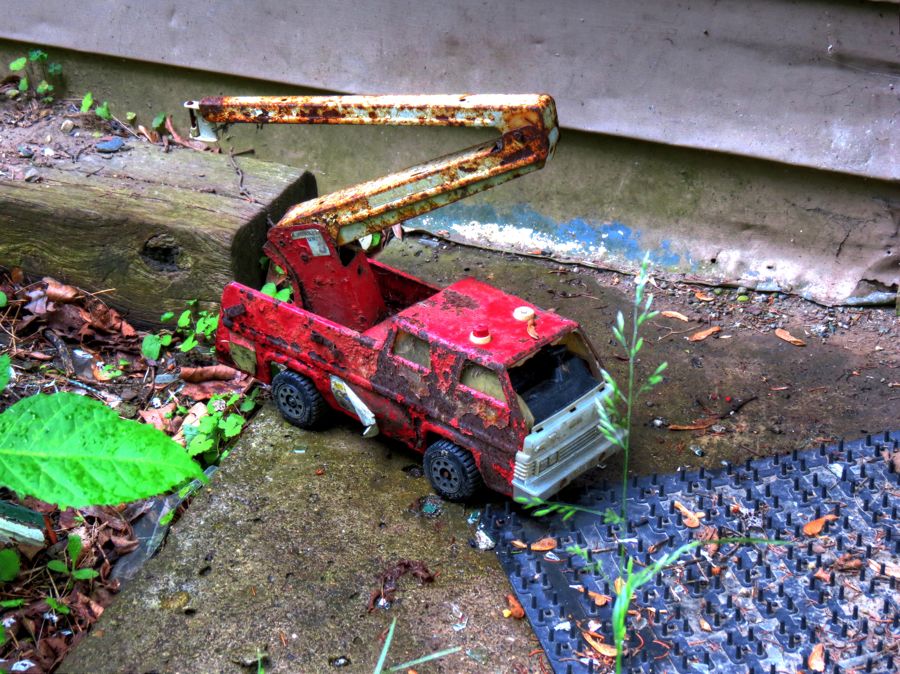 Other parts of Ohio were hard to explain. Why would someone want to mount a fairly rare Ford Ranchero on top of a welded set of steel pipes?  I stopped just outside of Blissfield to get a photo of all these cows vying for favored places in the shade of a single tree. Naturally I spotted a "covered bridge" sign and had to follow it.  The road led to one of Ohio's many "backyard oil wells," as I call them. This one wasn't operating on the day of my visit, but a lot of others were. These wells have been bolstering farmers' incomes for many decades.  The Helmick Covered Bridge was much longer—and much more original—than any of the others I'd seen on this trip. It stretches 166 feet over Killbuck Creek and was built in 1863.   Needless to say, I also found yet another Baptist church here!  As I drove past Blissfield, I spotted an interesting photo op out of the corner of my eye. A large brick building stood off to itself in the distance and appeared to be unused. Being completely unable to help myself, I doubled back and found the abandoned Blissfield School in the midst of a field.   Blissfield is still home to several families, although the population appears to be dwindling.  I bumped into Jennifer and a couple of her neighbors, who told me about the town. She grew up with her grandmother, who ran the post office from her framed-in front porch. Today, Jennifer lives in the same house and was pleased to show me the original letterbox that her grandmother used all those years. (Interestingly, Jennifer had visited Germany as a 16-year-old and had taken a tour of the BMW factory in Munich. She was startled to see the assembly line workers drinking beer on the job! They would toss their bottle caps to the tourists as souvenirs.)  Back in the day, this house served as a general store, gas station, and residence. I'm convinced that every place has a story behind it. Thanks, Jennifer, for filling me in on Blissfield's.  Roscoe Village, in Coshocton, OH, was once a thriving town on the Ohio and Erie Canal. The subsequent development of the railroads, together with the catastrophic flood of 1913, spelled doom for the village. The subsequent Great Depression finished off what few businesses were left, and by the 1970s vandalism and gang violence had become a serious problem for the residents. Thanks to the pioneering efforts of Edward and Frances Montgomery, however, Roscoe Village underwent a dramatic turnaround, with renovation of the historic buildings and many new shops, restaurants, and exhibits to attract tourists.  In this photo, the closest building housed a hotel, drug store, and hardware store. 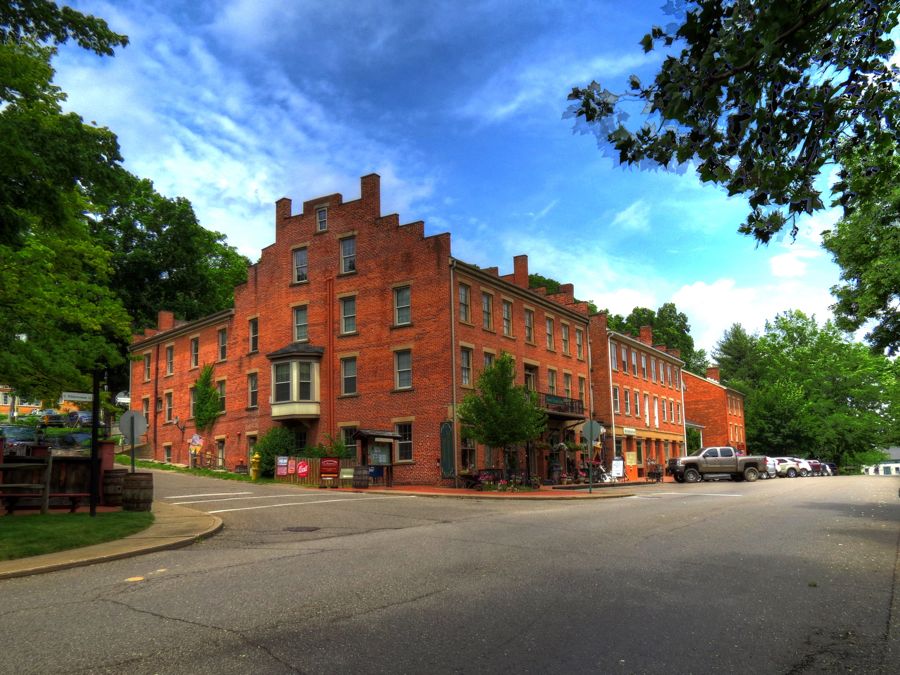 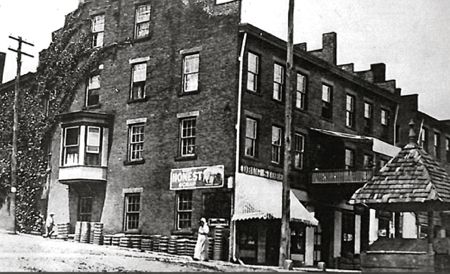 The village's sidewalks are still paved with bricks.  The blacksmith's shop was the hottest place in town, on what was already a hot day. But it was fun to talk with Jim and watch him turn an old railroad spike into an impressive knife.   The old toll-taker's house is now a museum. Anyone want to guess what this device is?  In the basement of the museum, I found an extraordinary collection of vintage children's toys. The owner, Rick, has been collecting for more than 50 years, and let me tell you: this guy really enjoys old toys. He happily demonstrated one after another, and it was quite a sight.   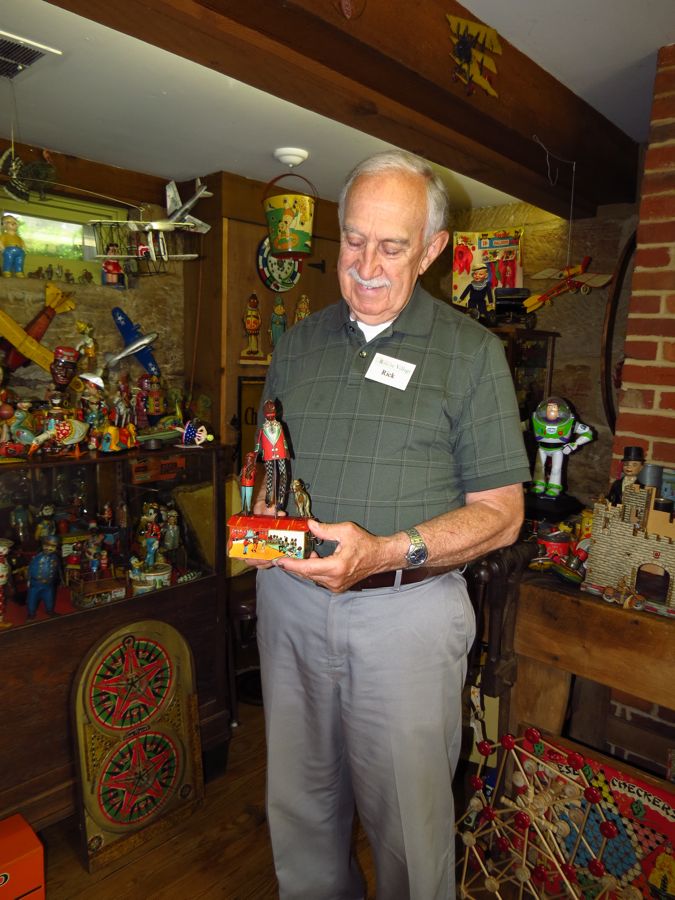 As I reluctantly moved on and drove through Cochocton itself, I had to stop at the scenic former firehouse.  And then I encountered yet another "car up on pipes." This one (an old Morris Minor, I believe) was at least being used to advertise an automotive junk yard.  I may need to start wearing blinders on these trips. Once again, the corner of my eye spotted something vaguely covered-bridge-like in the distance. It proved to be the Indian Camp bridge, from 1855. I tried wading through the deep foliage to get a stream-side photo, but halfway there I started worrying about Queen Snakes and Gulley Cats, so I gave up. At only 36 feet long, this was the shortest covered bridge I encountered. (Somewhere in Defiance, Ohio, there's a covered bridge that's only 9 feet long.)  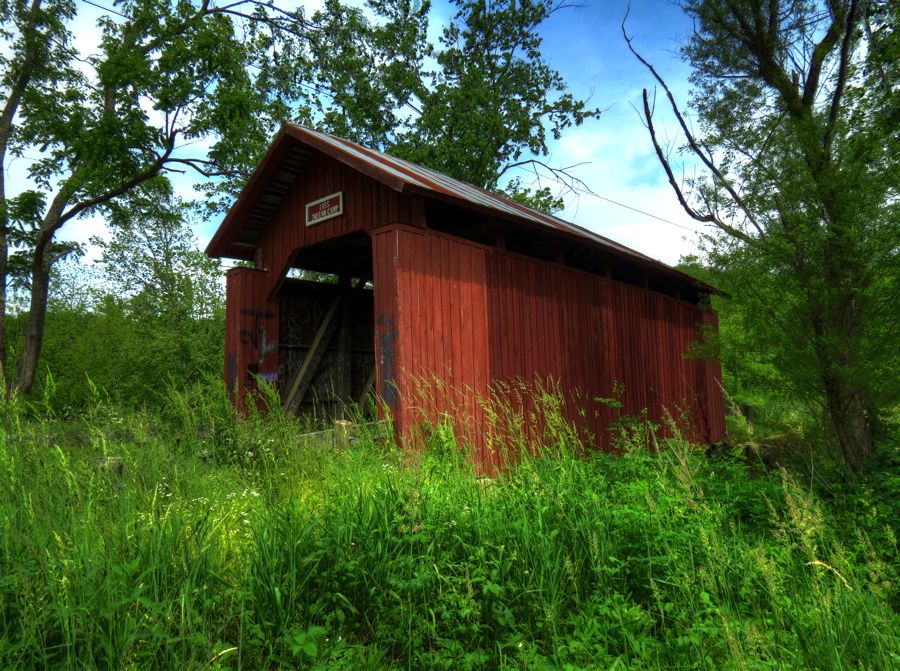 As best I can tell, this building used to be a school. Or a mill. Or possibly a church. Where's an historical marker when you need it?  Eventually, after 140 miles of touring and boy-racer fun, my path recrossed Interstate 70 and it was time to head back east to home. However, I couldn't resist a quick stop by my favorite almost-ghost town of Sewellsville. Here are two pairs of "before and after" photos, showing one of the houses and the old school from 2006 and my current trip. Another few years and that house will be gone altogether. But the school seems to be holding up well, even if it's getting progressively more hidden behind the vines.     With a quick pass through Hendrysville—birthplace of Hopalong Cassidy (actor William Boyd) in case you were wondering—it was back onto I-70 and a 5-hour jaunt back to Catonsville. I couldn't resist this multi-colored, multi-siding'd home. Sometimes it's best if they don't make them like they used to.  All told, my trip was 1,315 miles over three days. The Z4 was truly in its element on the twisting back roads of Ohio—and it graciously accepted the occasional puttering around dirt paths in search of the perfect photo. And if you've always thought that Ohio is flat, boring, and totally devoid of fun roads for driving, I challenge you to get out there soon and give 555, 93, 56, 39, and/or 541, a try. Better yet, get the RoadRunner route and do the entire thing! Rick F. Last edited by Rick F.; 09-23-2015 at 03:59 PM.. |
|
Appreciate
0
|
| 06-25-2013, 01:27 AM | #4 |
|
Second Lieutenant
 15
Rep 279
Posts |
Very cool.
You, my good sir, know how to put a roadster to good use. A camera too. Hope you are enjoying retirement! I am going to show this to my neighbor, who isn't a BMW fan(CHP sergeant) but is from Ohio. I'm sure he'll get a kick out of them. Love the history! |
|
Appreciate
0
|
| 06-25-2013, 02:48 PM | #7 |
|
Private First Class
 
8
Rep 147
Posts |
Great write up and pics,love those old barns.
__________________
|
|
Appreciate
0
|
| 06-25-2013, 04:03 PM | #8 |
|
Major
 
156
Rep 1,134
Posts
Drives: '07 M Roadster
Join Date: Dec 2011
Location: Warner Robins, GA
|
Another awesome drive and write up! Some familiar places too. My parents (more so because of my mother) have been to the Longaberger HQ a few times.
Have you thought about putting any of these trips into a book?
__________________
|
|
Appreciate
0
|
| 06-25-2013, 04:28 PM | #9 |
|
Lieutenant
   
111
Rep 494
Posts |
Every time you post these, it makes me want to go on all sorts of adventures. Sadly, they don't usually happen, but I always enjoy the read. Great stuff.
|
|
Appreciate
0
|
| 06-25-2013, 05:13 PM | #10 |
|
First Lieutenant
  7
Rep 376
Posts |
Rick, another excellent adventure. Darn it. This time you caught me at work, but I couldn't quit reading. I loved "The Castle" (let me know when you live there!) and several of the other old mansions. Also, do you know how many years it has been since I listened to Hot Tuna!! One question, when you do your HDR 3 photos, what range of F-Stops are you using? Is it -1, 0, +1 or a little more extreme? Thank you so much and looking forward to an autographed copy of "your book" when it's available.
__________________
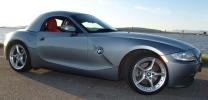 |
|
Appreciate
0
|
| 06-26-2013, 03:34 PM | #11 |
|
Iron Ring

11
Rep 316
Posts |
Fascinating!
Thanks for telling me!
Just scrolled down ( as I was about to walk out the door!) Images are incredible! Look forward to reading....off to see my Sister who somehow is with us 6 years after diagnosis. (inoperable big C) Hard to put this down, but have to... DaveL edit: back and thoroughly enjoyed each image and description. A a long time resident of London Ontario, where there are no curvy roads, I suspected sports car heaven might touch Ohio. (as a longtime member of Trillium West Miata Club, we did find some good roads. Took some travel, and great optimism to enjoy!)
__________________
DaveL///Toronto. http://www.ironring.ca/
My wife's cars: Had a few... I'm the Navigator, capable of getting us lost at any time! Drives are longer! Last edited by DaveL--2mnycars; 06-26-2013 at 10:23 PM.. Reason: Sometimers! |
|
Appreciate
0
|
| 06-27-2013, 08:22 AM | #12 |
|
Lieutenant
   
9
Rep 452
Posts |
Rick, you made another great story from things that few of us ever bothered to consider. Especially liked the part of the Guitar Ranch and how the members of Jefferson Airplane went far and wide after their breakup. Grace Slick herself might still be found in and around the San Francisco Bay area. She is a bit of a prolific artist these days. We attended an opening of her work in a gallery in Sausalito a few years ago. Few of us would recognize her now, but she is as creative as ever.
Thanks, and keep them coming!
__________________
Vibra Technics engine mounts / Rogue trans mounts / Stoptech brakes / original owner
|
|
Appreciate
0
|
| 06-28-2013, 12:58 PM | #13 |
|
More of this than that!

30
Rep 817
Posts |
Awesome road trip....this does give a completely different view of what that state looks like...not just all flat and filled with crops.
Keep these coming...I can't wait for the next adventure.
__________________
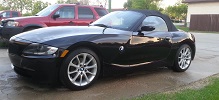 '06 Z4 3.0i Jet Black/ Biege/Black Leather / Premium Package / DICE Silverline DUO / Stubby Antenna / Matte Black Grill Ultimate Cup Holder x2 / Gaptech RCH+ / First Aid storagebox x2 / Acrylic Wind Deflector |
|
Appreciate
0
|
| 06-28-2013, 05:33 PM | #14 | |
|
Lieutenant Colonel
 962
Rep 1,910
Posts |
Quote:
My poor 3.0i roadster has been through a lot in its efforts to transport me to lost and forgotten places. It's perfect for 90% of my travels, being fun to drive, reliable, and offering excellent top-down visibility for spotting cool stuff. The other 10% of the time I need a Jeep or some such. But I'd much rather err on the side of using the Z4 as a Jeep than on the side of trying to make a Jeep perform like a Z4! Retirement is going very well, thanks. In particular, it's allowed me to take longer trips such as the one to Ohio, and mid-week trips, too. Hope your CHP neighbor enjoys the report! Rick |
|
|
Appreciate
0
|
| 06-28-2013, 05:37 PM | #15 |
|
Lieutenant Colonel
 962
Rep 1,910
Posts |
itdnwiwbp,
Stayed tuned--I've got another one in the works, and it's a doozy (Duesy?), with some of the most spectacular mansions imaginable (both active and abandoned). And a fun old Italian fellow, a really pretty young lady, and Eleanor Roosevelt's pet chipmunk. (Honest! Well, mostly honest…) Rick |
|
Appreciate
0
|
| 06-28-2013, 05:41 PM | #16 | |
|
Lieutenant Colonel
 962
Rep 1,910
Posts |
Quote:
My pleasure! I'm glad you enjoyed the trip. Of course, I need to go back and see the Mansfield Reformatory plus some other things I didn't have time for…  That reminds me: At my retirement luncheon, my special assistant Cathy commented that "Rick takes all these great car trips, but he's only ever recommended two places to me--the Eastern State Penitentiary and the Trans-Allegheny Lunatic Asylum!" After my return trip to Ohio, I'll be able to recommend a third.  Rick |
|
|
Appreciate
0
|
| 06-28-2013, 05:45 PM | #17 |
|
Lieutenant Colonel
 962
Rep 1,910
Posts |
boomer,
There were so many wonderful old barns in Ohio that I had to force myself not to stop and photograph every single one--I'd still be there if I'd tried to get them all. There's something about the texture of old wood and the variety of designs, not to mention the possible history of each place. I'm glad you enjoyed the trip report. Rick |
|
Appreciate
0
|
| 06-28-2013, 05:48 PM | #18 | |
|
Lieutenant Colonel
 962
Rep 1,910
Posts |
Quote:
Thanks! Although my wife and I have a number of Longaberger baskets, I hadn't previously realized that the company's headquarters is designed as it is. Pretty amazing. (The handles alone weigh something like 10 tons.) One of these days I'll investigate what it would take to collect these stories into one or more books. I'm confident that I could sell at least 10 of them and give away perhaps another 20…  Rick |
|
|
Appreciate
0
|
| 06-28-2013, 06:04 PM | #19 | |
|
Lieutenant Colonel
 962
Rep 1,910
Posts |
Quote:
I'm glad you enjoyed the Ohio report, and I hope you can get out there soon for some adventures of your own. It's so much fun to use our Z's the way they were built to be used--and to justify it based on the "historical experience" or the "beautiful scenery"! Keep trying!! Rick |
|
|
Appreciate
0
|
| 07-01-2013, 11:34 AM | #20 | |
|
Lieutenant Colonel
 962
Rep 1,910
Posts |
Quote:
Glad you enjoyed the story, and I hope you didn't get into any trouble at work! Regarding Hot Tuna, they've had several new albums in recent years, and I've enjoyed hearing them at concerts. It's amazing enough what Jorma can do on an accoustic guitar, but it's even more mind-blowing when Jack repeats the same lick on the bass! For my HDR photos, I use ± 2 stops (which seems to be the most commonly recommended range). The overexposed shot captures the shadow detail pretty well, and ditto for the underexposed shot with the sky and other highlight detail. Here's an example, from one of my favorite pictures from the Ohio trip. (Somehow the ugly road sign disappeared in the process, too…  ) )    If you haven't already done so, check out the Photomatix Pro tutorials at HDR Software. Rick PS: If and when I ever publish a book of these reports, you'll get the first signed copy! |
|
|
Appreciate
0
|
| 07-01-2013, 11:40 AM | #21 | |
|
Lieutenant Colonel
 962
Rep 1,910
Posts |
Quote:
Thanks for the PM--I'm glad that your sister is doing better than expected. I'm very much enjoying your father's book about his WWII Navy adventures. I've laughed out loud in several places--including Mack's reference to "Commander John Percival deWinton Kitcat," who was, in fact, a real person--and his role in the early days of radar is quite interesting. Thanks again! Rick |
|
|
Appreciate
0
|
| 07-01-2013, 12:27 PM | #22 | |
|
Lieutenant Colonel
 962
Rep 1,910
Posts |
Quote:
I well remember my freshman year in college, when I first heard songs by the Jefferson Airplane. I was awestruck then and remain so today. Along the way, it was a lot of fun to get to know Jorma and Jack a bit, together with some other legendary rock performers from the 1960s, including the one shown below.  Care to hazard a guess as to who it is? Hints:
Thanks again, and I'll keep 'em coming! Rick |
|
|
Appreciate
0
|
Post Reply |
| Bookmarks |
|
|